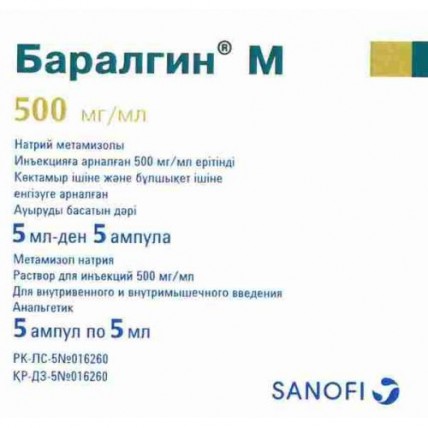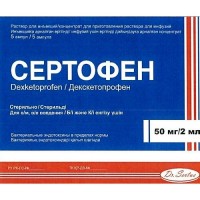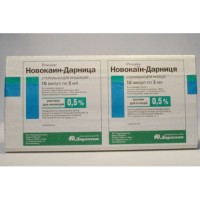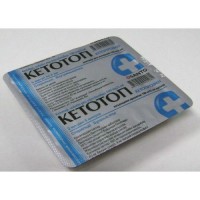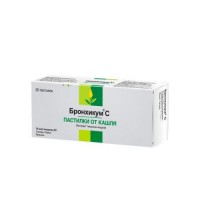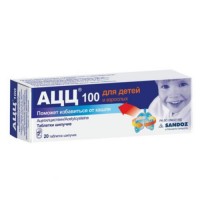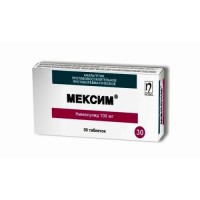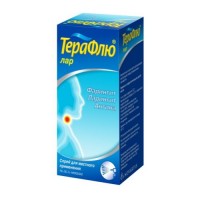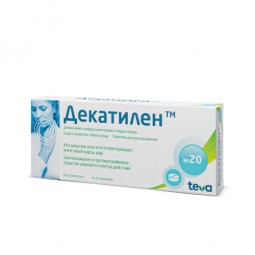Baralgin® 5-ml injection 5's
- $20.20
Out Of Stock
The instruction for medical use of BARALGIN® medicine M the Trade name of Baralgin® of M the International unlicensed name Metamizole Sodium Dosage Form Solution for injections of 500 mg/ml Structure of 1 ml of solution contains active agent - 500 mg of metamizole sodium, excipient - water for injections the Description Transparent solution from almost colourless till yellowish color, almost free from particles. Pharmacotherapeutic group Analgetics. Analgetics – antipyretics others. Pyrazyl ketones. Metamizole sodium. The ATX N02BB02 code the Pharmacological Pharmacokinetics Later properties of intravenous administration elimination half-life for metamizole sodium makes 14 minutes. Communication of an active metabolite with proteins of blood plasma – 50-60%. It is mainly removed by kidneys. About 96% are removed with urine in the form of metabolites. The pharmacodynamics of Baralgin® of M belongs to non-narcotic means, pyrazyl ketone derivatives. Possesses soothing, febrifugal and weak anti-inflammatory action. On the action mechanism practically does not differ from other non-steroidal anti-inflammatory drugs. As well as at the majority of non-steroidal anti-inflammatory drugs, the mechanism of effect of drug Baralgin® M is connected with oppression of production of prostaglandins. Indications - the severe pains and pains resistant to other treatment - the fever resistant to other treatment the Route of administration and doses Adults and teenagers of 15 years are also more senior: as a single dose 1-2 ml of 50% (500 mg / 1мл) Baralgin® solution M are recommended (in oil or in / c), the daily dose can make up to 4 ml of injection solution (no more than 2 d), divided into 2-3 receptions. The maximum single dose can make 1 g (2 ml of 50% of solution). Children and newborns: newborns cannot enter solution of Baralginum M aged up to 3 months or at body weight less than 5 kg. To children at the age of 3-12 months the introduction is carried out only intramusculary (the body weight of the child from 5 to 9 kg), in a dose of 50-100 mg on 10 kg of body weight (0.1 - 0.2 ml of 50% of solution). The single dose can be appointed up to 2-3 times a day. Before introduction solution is recommended to be heated to body temperature. At too fast administration of drug the critical falling of arterial blood pressure and shock can be observed. Intravenous administration has to be carried out slowly (rate of administering no more than 1 ml (500 mg of metamizol) a minute) in a prone position, at control of arterial blood pressure, pulse and respiration rate. As there is fear that falling of arterial blood pressure of not allergic genesis is dose-dependent, the amount of solution of Baralginum M more than 2 ml (1 d) has to be entered with extra care. Side effects Seldom - a malignant exudative erythema (Stephens-Johnson's syndrome), a toxic epidermal necrolysis (Lyell's disease), a bronkhospastichesky syndrome, anaphylactic and anaphylactoid reactions, in rare instances life-threatening - a leukopenia - disturbances from digestive tract Very seldom - a renal failure, in some cases an oliguria, an anury or a proteinuria, development of acute interstitial nephrite, coloring of urine in red color (at the expense of metabolite discharge – rubazonovy acid) - an agranulocytosis with typical signs, including inflammatory damages of a mucous membrane (for example, an oral cavity and a throat, anorectal, genital), a sore throat, fever (it is possible with a lethal outcome), the thrombocytopenia (raising a tendency to bleedings and petechias on skin and mucous membranes) Sometimes - an itching, burning, reddening, urticaria, dispnoe, a Quincke's edema - the renal failure, an oliguria, an anury, a proteinuria - is possible a lowering of arterial pressure (passing hypotension up to sharp falling), increase in arterial blood pressure, disturbance of a warm rhythm of the Contraindication - hypersensitivity to metamizol or other pyrazyl ketones (phenazone, propyphenazone) or Pyrazolidinums (phenylbutazone, oksifenbutazon), including earlier postponed agranulocytosis at reception of one of these drugs - dysfunction of marrow, for example, after treatment by cytostatics, or diseases of bodies of a hemopoiesis - the bronchial asthma and diseases which are followed by a bronchospasm - development of anaphylactoid reactions (urtikariya, rhinitis, a Quincke's disease) at intake of analgetics: salicylates, paracetamol, diclofenac, an ibuprofen, indometacin, Naproxenum - hypersensitivity to excipients as a part of drug - the sharp alternating hepatic porphyria (risk of emergence of attacks of a porphyria) - congenital deficit dehydrogenase glyukozo-6-phosphate (risk of hemolysis) - the profound abnormal liver functions and kidneys - the significant disturbances of a hemopoiesis: the agranulocytosis, a cytoplastic and infectious neutropenia - pregnancy (first and last trimester) - the lactation period - newborns aged up to 3 months or at body weight less than 5 kg - intravenous administration to children aged up to 12 months Medicinal interactions of Baralgin® of M strengthens sedative effect of alcohol. At use together with cyclosporine the decrease in concentration of cyclosporine in blood therefore it is necessary to control its concentration can take place. Simultaneous use of Baralginum M with other non-narcotic analgesics can lead to mutual strengthening of toxic effects. Tricyclic antidepressants, oral contraceptives, Allopyrinolum break metabolism of metamizol in a liver and increase its toxicity. Barbiturates, phenylbutazone and other inductors of microsomal enzymes of a liver weaken effect of Baralginum M. Sedatives and tranquilizers strengthen the anesthetizing effect of drug. Simultaneous use with Chlorpromazinum or other derivatives of a fenotiazin can lead ment of the expressed hyperthermia. X-ray contrast substances, colloidal blood substitutes and penicillin should not be applied during treatment by Baralginum M. Metamizol, forcing out oral hypoglycemic drugs, indirect anticoagulants, glucocorticosteroid means and indometacin from communication with protein, increases their activity. Thiamazolum and sarcolysine increase risk of development of a leukopenia. The effect is enhanced by codeine, histamine H2 blockers and propranolol. Special instructions At treatment of the patients receiving cytostatic means, intake of Baralginum M has to be carried out only under observation of the doctor. At prolonged use it is necessary to control a pattern of peripheral blood. The agranulocytosis caused by metamizol is reaction of the immuno-allergic nature, and not less than a week lasts. It is observed extremely seldom, can be a heavy course and lead to life-threatening states. Developing of an agranulocytosis does not depend on a dosage of drug and can occur treatments at any time. At emergence of unmotivated temperature rise, a fever, a sore throat, the complicated swallowing, stomatitis, erosive cankers of an oral cavity immediate drug withdrawal is necessary. In case of a neutropenia (less than 1.500 neutrophils/mm3) treatment it is necessary to stop and control immediately composition of blood before restoration of normal indicators. The acute anaphylaxis arises more often at patients with allergic reactions in the anamnesis. Therefore metamizol has to be appointed with care the patient with bronchial asthma and atopic dermatitis. When choosing a method of administration it is necessary to take into account that the parenteral route of administration is connected with the increased risk of anaphylactic/anaphylactoid reactions. In particular, the risk group is made by patients: - with bronchial asthma, especially with the accompanying polypostural rinosinusit - with a chronic small tortoiseshell - with intolerance of alcohol (patients react even to small amounts of alcoholic beverages sneezing, dacryagogue and face reddening). The alcoholic intolerance can serve as the indicator of not diagnosed syndrome of 'analgetic' asthma - with intolerance of dyes (for example, tartrazine) or preservatives (for example, benzoate). Before prescribing of drug it is necessary to interview the patient carefully. At identification of risk of anaphylactoid reactions it is necessary to weigh carefully a ratio 'advantage risk'. If drug is appointed to the patient from risk group, strict medical observation is necessary for acceptance of adequate measures. Isolated cases of hypotensive reactions Use of metamizol can cause hypotensive reactions in some cases. These reactions most often are dose-dependent and arise at patients at intravenous administration. To avoid serious hypotensive reactions such, intravenous administration should be carried out slowly. With initially existing hypotension, reduced volume of OCK, dehydration, circulator disorders or the beginning circulatory unefficiency it is necessary to achieve normalization of a hemodynamics from patients. The extra care is required at appointment as the patient with systolic arterial blood pressure lower than 100 mm Hg. or at instability of blood circulation owing ment of heart failure in a myocardial infarction, multiple injuries, shock, with anamnestic instructions on diseases of kidneys (pyelonephritis, a glomerulonephritis) and at the long alcoholic anamnesis. Use of drug for removal of a sharp abdominal pain is inadmissible (before clarification of the reason). At patients with an abnormal liver function and kidneys it is recommended to avoid intake of Baralginum M in big dosages. The intravenous injection has to be carried out very slowly (no more than 1 ml a minute) to be convinced that administration of drug can be stopped at the first signs of anaphylactic/anaphylactoid reactions and minimize risk of single hypotensive reactions. Pregnancy and feeding by a breast Metamizol is weak inhibitor of synthesis of prostaglandin, and at its use the probability of premature closing of an arterial channel and also emergence of perinatal complications owing to disturbance of aggregation of thrombocytes of mother and the newborn therefore within the first and last three months of pregnancy it is impossible to accept Baralgin® of M is not excluded. With fourth on the sixth months of pregnancy intake of Baralginum M has to be carried out on strict medical indications. Metabolites of metamizol are allocated with breast milk. In this regard after intake of Baralginum M the feeding by a breast has to be stopped for 48 hours. The feature of influence of medicine on ability to run the vehicle or potentially dangerous mechanisms At observance of the recommended mode of dosing of changes of concentration and attention is not observed. However when exceeding doses the decrease in concentration and speed of psychomotor reactions is possible, especially at joint reception with alcohol. Overdose in case of overdose it is necessary to consult with the doctor. Symptoms: nausea, vomiting, stomach aches, oliguria, hypothermia, lowering of arterial pressure, tachycardia, short wind, sonitus, dizziness, drowsiness, nonsense, consciousness disturbance, acute agranulocytosis, hemorrhagic syndrome, acute renal or liver failure, coma, arrhythmias, spasms, paralysis of respiratory muscles. Treatment is symptomatic. Specific antidote for metamizol does not exist. Carrying out an artificial diuresis, a hemodialysis is possible, at development of a convulsive syndrome – intravenous administration of diazepam and high-speed barbiturates. The main metabolite of metamizol (4 methylaminoantipyrine) can be removed by means of a hemodialysis, haemo filtration, hemoperfusion and a plasma exchange. The form of release and packing On 5 ml of drug place in ampoules from glass of yellow color type I. On 5 ampoules place in blister strip packaging from a film polyvinylchloride. On 1 blister strip packaging together with the instruction for medical use in the state and Russian languages place a pack from cardboard. To Store storage conditions in the place protected from light at a temperature not over 25C. To store out of children's reach! 4 years After an expiration date not to apply a period of storage. Prescription status According to the prescription the Producer of Sanofi India Limited, India the location Address: 3501-15, GIDC Estate, Ankleshwar – 393,002, Bharuch, Gujarat State India the Owner of the registration certificate of Sanofi India Limited, India the Address of the organization accepting in the territory of the Republic of Kazakhstan claims from consumers on quality of products (goods) 050013 Almaty, Furmanov St. of 187 B
